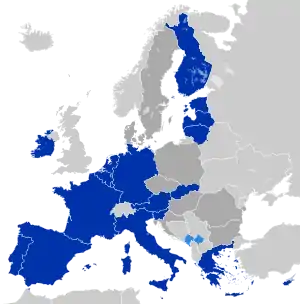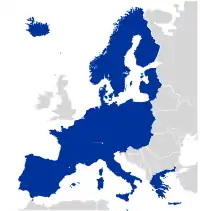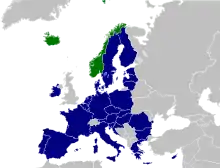European Atomic Energy Community
The European Atomic Energy Community (EAEC or Euratom) is an international organisation established by the Euratom Treaty on 25 March 1957 with the original purpose of creating a specialist market for nuclear power in Europe, by developing nuclear energy and distributing it to its member states while selling the surplus to non-member states. However, over the years its scope has been considerably increased to cover a large variety of areas associated with nuclear power and ionising radiation as diverse as safeguarding of nuclear materials, radiation protection and construction of the International Fusion Reactor ITER.[1]
European Atomic Energy Community
| |
|---|---|
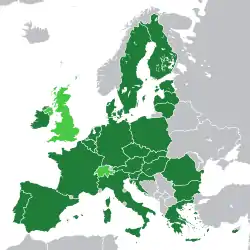
| |
| Administrative body | European Commission |
| Official languages | 24 languages |
| Type | International organisation |
| Members | 27 EU member states 1 associated state 1 acceding associated state |
| Establishment | 1958 |
| 1 January 1958 | |
| 1 July 1967 | |
It is legally distinct from the European Union (EU) although it has the same membership, and is governed by many of the EU's institutions; but it is the only remaining community organisation that is independent of the EU and therefore outside the regulatory control of the European Parliament. Since 2014, Switzerland has also participated in Euratom programmes as an associated state.[2]
The United Kingdom ceased to be a member of the organisation on 31 January 2020.[3][4] However, under the terms of the UK–EU Trade and Cooperation Agreement, the United Kingdom participates in Euratom as an associated state following the end of the transition period on 31 December 2020.[5]
History
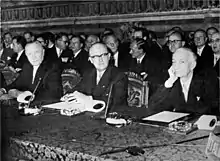
The Common Assembly proposed extending the powers of the European Coal and Steel Community to cover other sources of energy. However, Jean Monnet, ECSC architect and President, wanted a separate community to cover nuclear power. Louis Armand was put in charge of a study into the prospects of nuclear energy use in Europe; his report concluded that further nuclear development was needed to fill the deficit left by the exhaustion of coal deposits and to reduce dependence on oil producers. However, the Benelux states and Germany were also keen on creating a general single market, although it was opposed by France due to its protectionism, and Jean Monnet thought it too large and difficult a task. In the end, Monnet proposed the creation of separate atomic energy and economic communities to reconcile both groups.[6]
The Intergovernmental Conference on the Common Market and Euratom at the Château of Val-Duchesse in 1956 drew up the essentials of the new treaties. Euratom would foster co-operation in the nuclear field, at the time a very popular area, and would, along with the EEC, share the Common Assembly and Court of Justice of the ECSC, but not its executives. Euratom would have its own Council and Commission, with fewer powers than the High Authority of the European Coal and Steel Community. On 25 March 1957, the Treaties of Rome (the Euratom Treaty and the EEC Treaty) were signed by the ECSC members and on 1 January 1958 they came into force.[7][8][9]
To save on resources, these separate executives created by the Rome Treaties were merged in 1965 by the Merger Treaty. The institutions of the EEC would take over responsibilities for the running of the ECSC and Euratom, with all three then becoming known as the European Communities even if each legally existed separately. In 1993, the Maastricht Treaty created the European Union, which absorbed the Communities into the European Community pillar, yet Euratom still maintained a distinct legal personality.
The European Constitution was intended to consolidate all previous treaties and increase democratic accountability in them. The Euratom treaty had not been amended as the other treaties had, so the European Parliament had been granted few powers over it. However, the reason it had gone unamended was the same reason the Constitution left it to remain separate from the rest of the EU: anti-nuclear sentiment among the European electorate, which may unnecessarily turn voters against the treaty.[10][11][12] The Euratom treaty thus remains in force relatively unamended from its original signing.
EU evolution timeline
This overall timeline includes the establishment and development of Euratom, and shows that currently it is the only former EC body that has not been incorporated into the EU.
Since the end of World War II, sovereign European countries have entered into treaties and thereby co-operated and harmonised policies (or pooled sovereignty) in an increasing number of areas, in the so-called European integration project or the construction of Europe (French: la construction européenne). The following timeline outlines the legal inception of the European Union (EU)—the principal framework for this unification. The EU inherited many of its present responsibilities from the European Communities (EC), which were founded in the 1950s in the spirit of the Schuman Declaration.
| Legend: S: signing F: entry into force T: termination E: expiry de facto supersession Rel. w/ EC/EU framework: de facto inside outside |
[Cont.] | |||||||||||||||
| (Pillar I) | ||||||||||||||||
| European Atomic Energy Community (EAEC or Euratom) | [Cont.] | |||||||||||||||
| European Economic Community (EEC) | ||||||||||||||||
| Schengen Rules | European Community (EC) | |||||||||||||||
| 'TREVI' | Justice and Home Affairs (JHA, pillar II) | |||||||||||||||
| [Cont.] | Police and Judicial Co-operation in Criminal Matters (PJCC, pillar II) | |||||||||||||||
Anglo-French alliance |
[Defence arm handed to NATO] | European Political Co-operation (EPC) | Common Foreign and Security Policy (CFSP, pillar III) | |||||||||||||
| [Tasks defined following the WEU's 1984 reactivation handed to the EU] | ||||||||||||||||
| [Social, cultural tasks handed to CoE] | [Cont.] | |||||||||||||||
- ¹Although not EU treaties per se, these treaties affected the development of the EU defence arm, a main part of the CFSP. The Franco-British alliance established by the Dunkirk Treaty was de facto superseded by WU. The CFSP pillar was bolstered by some of the security structures that had been established within the remit of the 1955 Modified Brussels Treaty (MBT). The Brussels Treaty was terminated in 2011, consequently dissolving the WEU, as the mutual defence clause that the Lisbon Treaty provided for EU was considered to render the WEU superfluous. The EU thus de facto superseded the WEU.
- ²The treaties of Maastricht and Rome form the EU's legal basis, and are also referred to as the Treaty on European Union (TEU) and the Treaty on the Functioning of the European Union (TFEU), respectively. They are amended by secondary treaties.
- ³The European Communities obtained common institutions and a shared legal personality (i.e. ability to e.g. sign treaties in their own right).
- ⁴Between the EU's founding in 1993 and consolidation in 2009, the union consisted of three pillars, the first of which were the European Communities. The other two pillars consisted of additional areas of cooperation that had been added to the EU's remit.
- ⁵The consolidation meant that the EU inherited the European Communities' legal personality and that the pillar system was abolished, resulting in the EU framework as such covering all policy areas. Executive/legislative power in each area was instead determined by a distribution of competencies between EU institutions and member states. This distribution, as well as treaty provisions for policy areas in which unanimity is required and qualified majority voting is possible, reflects the depth of EU integration as well as the EU's partly supranational and partly intergovernmental nature.
- ⁶Plans to establish a European Political Community (EPC) were shelved following the French failure to ratify the Treaty establishing the European Defence Community (EDC). The EPC would have combined the ECSC and the EDC.
Cooperation
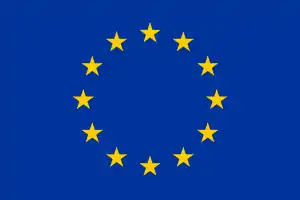 |
|---|
| This article is part of a series on the politics and government of the European Union |
|
|
- Since 2014, Switzerland has participated in Euratom programmes as an associated state.[2]
- As of 2020, the community had Co-operation Agreements of various scopes with nine countries: Armenia, Australia, Canada, Japan, Kazakhstan, Ukraine, United States, Uzbekistan, and South Africa.[13][14]
- From 1 January 2021, the United Kingdom shall participate in Euratom programmes as an associated state under the draft terms of the UK-EU Trade and Cooperation Agreement. [5]
Withdrawal of the United Kingdom
The United Kingdom announced its intention to withdraw from the EAEC on 26 January 2017, following on from its decision to withdraw from the European Union.[13][15][16][17] Formal notice to withdraw from the EAEC was provided in March 2017, within the Article 50 notification letter, where the withdrawal was made explicit.[18] Withdrawal only became effective following negotiations on the terms of the exit, which lasted two years and ten months.
A report by the House of Commons Business, Energy and Industrial Strategy Committee, published in May 2017, questioned the legal necessity of leaving Euratom and called for a temporary extension of membership to allow time for new arrangements to be made.[19]
In June 2017, the European Commission's negotiations task force published a Position paper transmitted to EU27 on nuclear materials and safeguard equipment (Euratom), titled "Essential Principles on nuclear materials and safeguard equipment".[20] The following month, a briefing paper from the House of Commons Library assessed the implications of leaving Euratom.[21]
In 2017, an article in The Independent questioned availability of nuclear fuel to the UK after 2019 if the UK were to withdraw, and the need for new treaties relating to the transportation of nuclear materials.[22] A 2017 article in the New Scientist stated that radioisotope supply for cancer treatments would also need to be considered in new treaties.[23]
UK politicians speculated that the UK could stay in Euratom. In 2017, some argued that this would require – beyond the consent of the EU27 – amendment or revocation of the Article 50 letter of March 2017.[24]
The Nuclear Safeguards Act 2018, making provision for safeguards after withdrawal from Euratom, received royal assent on 26 June 2018.[25]
The UK-EU Trade and Cooperation Agreement, outlining the UK's relationship with the European Union from 1 January 2021, makes provision for the United Kingdom's participation "as an associated country of all parts of the Euratom programme".[5]
Achievements
In the history of European regulation, Article 37 of the Euratom Treaty represents pioneering legislation concerning binding transfrontier obligations with respect to environmental impact and protection of humans.[26]
Presidents of the EAEC
The five member Commission was led by only three presidents while it had independent executives (1958–1967), all from France:
| N. | Portrait | President (Born–Died) |
State | Took office | Left office | Commission | Party | Group | Electoral mandate | Refs | |
|---|---|---|---|---|---|---|---|---|---|---|---|
| 1 | Louis Armand (1905–1971) |
7 January 1958 | 2 February 1959 | Armand | Independent | None | – | ||||
| 1 year, 26 days | |||||||||||
| 2 | .png.webp) |
Étienne Hirsch (1901–1994) |
2 February 1959 | 10 January 1962 | Hirsch | Independent | None | – | |||
| 3 years, 8 days | |||||||||||
| 3 | Pierre Chatenet (1917–1997) |
10 January 1962 | 5 July 1967 | Chatenet | Independent | None | – | ||||
| 5 years, 176 days | |||||||||||
See also
- EU Directorate General Joint Research Centre – often incorrectly referred to as Euratom due to EURATOM being its origin.
- Energy Community
- Energy policy of the European Union
- History of the European Union
- Institutions of the European Union
- International Atomic Energy Agency
- Nuclear energy in the European Union
- The nuclear part of the Seventh Framework Programme for research and technological development, the European Union's chief instrument for funding research.
References
- Energy, Fusion For. "Fusion For Energy - Bringing the power of the sun to earth". fusionforenergy.europa.eu.
- Document 32014D0954, Council of the European Union. Retrieved 26 October 2015.
- European Union (Notification of Withdrawal) Act 2017 (c. 9) EXPLANATORY NOTES, p. 4: "The power that is provided by section 1(1) applies to withdrawal from the EU. This includes the European Atomic Energy Community (‘Euratom’), as the European Union (Amendment) Act 2008 sets out that the term “EU” includes (as the context permits or requires) Euratom (section 3(2))."
- Hinson, Suzanna (8 January 2020). "Commons Briefing papers CBP-8036". Cite journal requires
|journal=(help) - "Draft EU-UK Declarations" (PDF). European Commission. p. 21. Retrieved 26 December 2020.
- 1957–1968 Successes and crises CVCE
- A European Atomic Energy Community CVCE
- The signing of the Rome Treaties CVCE
- Drafting of the Rome Treaties CVCE
- Euratom: nuking Europe's future Greenpeace International, 9 July 2003
- One hundred civil society groups say abolish Euratom! Archived 23 May 2008 at the Wayback Machine Friends of the Earth Europe, 3 March 2003
- "Euratom Loans". www.eu-energy.com.
- Alex Barker, Arthur Beesley (26 January 2017). "UK confirms plan to leave European atomic energy community". Financial Times. Retrieved 27 January 2017.
- Armenian president declares readiness to enhance cooperation with European Union, 3 May 2018.
- Gosden, Sam Coates, Emily (21 December 2017). "Britain quits European nuclear body" – via www.thetimes.co.uk.
- Adam Vaughan (27 January 2017). "UK exit from EU atomic treaty under Brexit 'will delay power stations'". The Guardian. Retrieved 27 January 2017.
- Gibney, Elizabeth. "Researchers shocked at UK's plan to exit EU nuclear agency". Nature. doi:10.1038/nature.2017.21388.
- "Prime Minister May's letter to EU" (PDF). Government of the United Kingdom. 29 March 2017. Retrieved 1 April 2017.
- "Government must act urgently to end Brexit risk to nuclear industry". UK Parliament. Retrieved 8 July 2017.
- "Position paper transmitted to EU27 on nuclear materials and safeguard equipment (Euratom)". European Commission. 23 June 2017. Retrieved 27 June 2017.
- Hinson, Suzanna (7 July 2017). "Briefing Paper CBP 8036: Euratom". UK Parliament. Retrieved 8 July 2017.
- "Brexit will create 'an alarming mess' for UK nuclear industry, scientists warn". The Independent. 9 July 2017.
- "Brexiteers must not risk UK's nuclear future by leaving Euratom". The New Scientist. 12 July 2017.
- "Brexit: what happens to Article 50 in a U-turn on Euratom?". Financial Times. Retrieved 11 July 2017.
- "Bill stages — Nuclear Safeguards Act 2018 — UK Parliament". parliament.uk. Parliament of the United Kingdom. Retrieved 9 July 2018.
- Heuel-Fabianek, B., Kümmerle, E., Möllmann-Coers, M., Lennartz, R. (2008): The relevance of Article 37 of the Euratom Treaty for the dismantling of nuclear reactors. atw – International Journal for Nuclear Power 6/2008 Archived 11 September 2008 at the Wayback Machine
External links
| Wikimedia Commons has media related to European Atomic Energy Community. |
- Official website
- Treaty establishing the European Atomic Energy Community (EURATOM)
- Documents of the European Atomic Energy Community are consultable at the Historical Archives of the EU in Florence
- History of the Rome Treaties Online collection by the CVCE
- European Commission Fusion Research
- European Commission Fission Research

